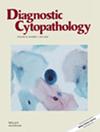Molecular Testing Using ThyGeNEXT/ThyraMIR in Thyroid Nodules With Indeterminate Cytology: A Single Medical Institute Experience
Abstract
Background
Up to 30% of thyroid nodules, by fine needle aspiration (FNA), have indeterminate cytology, including Bethesda III (atypia of undetermined significance [AUS]), IV (follicular neoplasm/suspicious for follicular neoplasm [FN/SFN]), and V (suspicious for malignancy). Molecular testing is utilized for further risk stratification of these indeterminate thyroid nodules. A multiplatform test (MPTX), one of the commercially offered molecular tests, combines next-generation sequencing panel (ThyGeNEXT) with microRNA expression classifier (ThyraMIR) to help with risk stratification. This study aimed to evaluate the performance of MPTX in cytologically indeterminate thyroid nodules in real-world experience.
Methods
All cases with indeterminate thyroid FNA results and corresponding MPTX test results in a period of 5 years were searched and retrieved. Subsequent clinical or surgical follow-up information was obtained. Molecular test results were compared to the histologic diagnoses. The sensitivity, specificity, positive predictive value (PPV), and negative predictive value (NPV) were calculated accordingly.
Results
A total of 106 cases were identified in the search, including 89 Bethesda III and 17 Bethesda IV. Overall MPTX results were negative in 59 cases, positive in 36 cases, and nondiagnostic in 11 cases. Only 17% of cases with negative molecular results had surgery, whereas 86% of those with positive molecular results had surgical follow-up. The false negative rate and false positive rate based on cytologic-histologic correlation (CHC) alone were 70% and 29%, respectively. In addition, based on both surgical and clinical follow-up data, the MPTX tests had an overall sensitivity of 76%, specificity of 75%, NPV of 83%, and PPV of 67%.
Conclusions
This study showed that more than half (56%) of the thyroid nodules with indeterminate cytology had benign molecular results by MPTX testing. The MPTX test showed moderate to high NPV and moderate PPV, suggesting that the MPTX test can be useful as an ancillary study to further risk-stratify cytologically indeterminate thyroid nodules. It is critical, however, to know the limitations of this assay, and the molecular results should be considered in correlation with clinical and radiologic findings.

 求助内容:
求助内容: 应助结果提醒方式:
应助结果提醒方式:


